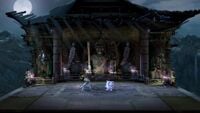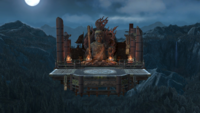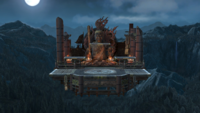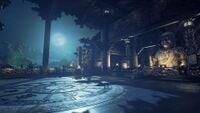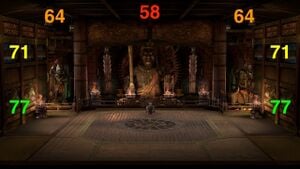Mishima Dojo: Difference between revisions
m (→Trivia) |
Aidanzapunk (talk | contribs) m (→Trivia) |
||
| (10 intermediate revisions by 5 users not shown) | |||
| Line 4: | Line 4: | ||
|name = Mishima Dojo | |name = Mishima Dojo | ||
|image = [[File:SSBU-Mishima Dojo.png|300px]] | |image = [[File:SSBU-Mishima Dojo.png|300px]] | ||
|caption = [[File:TekkenSymbol.svg|50px|class=invert]]<br>Mishima Dojo in ''[[Super Smash Bros. Ultimate]]''. | |caption = [[File:TekkenSymbol.svg|50px|class=invert-dark]]<br>Mishima Dojo in ''[[Super Smash Bros. Ultimate]]''. | ||
|universe = {{uv|Tekken}} | |universe = {{uv|Tekken}} | ||
|games = ''[[Ultimate]]'' | |games = ''[[Ultimate]]'' | ||
| Line 18: | Line 18: | ||
==Stage overview== | ==Stage overview== | ||
[[File:MishimaDojoBrokenWalls.jpg|thumb|left|Mishima Dojo with its walls and ceiling broken.]] | [[File:MishimaDojoBrokenWalls.jpg|thumb|left|Mishima Dojo with its walls and ceiling broken.]] | ||
The stage's layout is primarily flat, with walls and ceiling sections blocking the left, right and upper blast zones. These can be broken by being attacked or if a fighter is launched into them, with a [[Special Zoom]] | The stage's layout is primarily flat, with walls and ceiling sections blocking the left, right and upper blast zones. These can be broken by being attacked or if a fighter is launched into them, with a [[Special Zoom]] occurring in the latter event if the fighter is launched with enough force that they will likely be KO'd. After being broken, they will repair themselves after a certain amount of time has passed. If the lower wall is destroyed, it is possible to die from the lower blast zone. Otherwise, a shallow wall prevents fighters dropping below the lower wall, even when the upper wall is destroyed. The amount of damage a surface takes from fighters being knocked into them depends on the speed of the collision, and the [[weight]] of the fighter, with heavier fighters requiring less knockback to be launched through the walls and ceiling. | ||
[[Heihachi Mishima]] can be seen in front of the large [[wikipedia:Acala|Fudō Myōō]] statue in the center of the stage, sitting faced away from the action with his arms crossed. When the fighters hit the walls and ceiling, he'll react to it by looking left and right, depending on which walls and ceilings fighters hit. He'll get up, cross up his arms and react to KOs once parts of the walls and ceilings are broken. He does not appear in the background in 8-player battles. | |||
There is a small inscription on the floor that roughly translates to "[https://tekken.fandom.com/wiki/Kazumi_Mishima Kazumi] and [https://tekken.fandom.com/wiki/Heihachi_Mishima Heihachi]." This is a reference to ''Tekken'' lore, where both carved their names into the floor as a symbol of their love. | There is a small inscription on the floor that roughly translates to "[https://tekken.fandom.com/wiki/Kazumi_Mishima Kazumi] and [https://tekken.fandom.com/wiki/Heihachi_Mishima Heihachi]." This is a reference to ''Tekken'' lore, where both carved their names into the floor as a symbol of their love. | ||
| Line 40: | Line 42: | ||
==Tournament Legality== | ==Tournament Legality== | ||
Mishima Dojo is widely banned in tournaments due to | Mishima Dojo is widely banned in tournaments due to the stage being enclosed by two walls and a celing at the start of every match. This can allow for infinites under specific circumstances. While the walls and ceiling are destructible to mitigate this issue, the blast zones are close to the stage, heavily favoring characters with high base knockback once the walls are broken. | ||
==Gallery== | ==Gallery== | ||
| Line 76: | Line 78: | ||
*Mishima Dojo is one of four stages in the ''Super Smash Bros.'' series to originate from a different fighting game, with the others being [[Suzaku Castle]], [[King of Fighters Stadium]], and [[Spring Stadium]]. | *Mishima Dojo is one of four stages in the ''Super Smash Bros.'' series to originate from a different fighting game, with the others being [[Suzaku Castle]], [[King of Fighters Stadium]], and [[Spring Stadium]]. | ||
*The HP of the dojo surfaces varies, depending on how close they are to the stage's ledges, with the central ceiling having the lowest HP, and the lower walls having the highest. | *The HP of the dojo surfaces varies, depending on how close they are to the stage's ledges, with the central ceiling having the lowest HP, and the lower walls having the highest. | ||
*Mishima Dojo is the first stage which did not appear on Nintendo hardware before its debut in the ''Super Smash Bros.'' series. | *Mishima Dojo is the first and only stage which did not appear on Nintendo hardware before its debut in the ''Super Smash Bros.'' series. | ||
**Excluding ''Smash'' original content, it is unique among all [[fighter]]s, stages, [[Assist Trophies]], [[Alternate costume (SSBU)/Mii Fighter|Mii Fighter costumes]], [[boss]]es, and [[item]]s in that its only appearance on Nintendo hardware is in the ''Super Smash Bros.'' series. | |||
*[[Andross]], [[Arcade Bunny]], [[Color TV-Game 15]], [[Devil]], [[Dr. Wright]], [[Flies & Hand]], [[Kapp'n]], [[Moon]], [[Nikki]] (due to the dark background obscuring her drawings), [[Nintendog]], and [[Thwomp]] cannot appear from [[Assist Trophy|Assist Trophies]] on this stage. [[Abra]], [[Alolan Exeggutor]], [[Lugia]], and [[Lunala]] cannot be summoned from [[Poké Ball]]s. | *[[Andross]], [[Arcade Bunny]], [[Color TV-Game 15]], [[Devil]], [[Dr. Wright]], [[Flies & Hand]], [[Kapp'n]], [[Moon]], [[Nikki]] (due to the dark background obscuring her drawings), [[Nintendog]], and [[Thwomp]] cannot appear from [[Assist Trophy|Assist Trophies]] on this stage. [[Abra]], [[Alolan Exeggutor]], [[Lugia]], and [[Lunala]] cannot be summoned from [[Poké Ball]]s. | ||
*Because [[stage element]]s are frozen during [[Training Mode]] when the game is paused, when the opponent takes very high knockback, the surfaces remain intact unless the game is unpaused. | *Because [[stage element]]s are frozen during [[Training Mode]] when the game is paused, when the opponent takes very high knockback, the surfaces remain intact unless the game is unpaused. | ||
*Masahiro Sakurai showed an early version of Mishima Dojo in a [[YouTube]] video<ref>[https://www.youtube.com/watch?v=wKQ2v9kno9I=498s Odds and Ends of Supervising [Graphics]]</ref> and showcased several changes made before the final version: | *It is possible for {{SSBU|Jigglypuff}} to clip through the shallow wall preventing access to the lower blast zone, by using an uncharged Rollout while facing outwards and in contact with the wall. However, the lower internal wall being present prevents fighters from grabbing the ledge regardless. | ||
*Masahiro Sakurai showed an early version of Mishima Dojo in a [[YouTube]] video<ref>[https://www.youtube.com/watch?v=wKQ2v9kno9I=498s Odds and Ends of Supervising <nowiki>[Graphics]</nowiki>]</ref> and showcased several changes made before the final version: | |||
**Sakurai suggested adding more visual detail to the background elements close to the [[Blast line]], as those would be the most visible areas. | **Sakurai suggested adding more visual detail to the background elements close to the [[Blast line]], as those would be the most visible areas. | ||
***The mountain ridge lines were made to reflect moonlight more. | ***The mountain ridge lines were made to reflect moonlight more. | ||
| Line 92: | Line 96: | ||
**More moon shafts were added after the ceiling collapses. | **More moon shafts were added after the ceiling collapses. | ||
**The colors on the [[Battlefield form]] platforms were altered to contrast more with the background. | **The colors on the [[Battlefield form]] platforms were altered to contrast more with the background. | ||
*In another YouTube video,<ref>[https://www.youtube.com/watch?v=rV1Vnt1dVlQ&t Destroying One Wall <nowiki>[Graphics]</nowiki>]</ref> Sakurai showcased the progression of the destroyed walls. In particular, he noted that the destruction looked too uniform early on, and requested the broken wall boards look more jagged and chaotic to appear as if something randomly crashed through it. | |||
==References== | ==References== | ||
Latest revision as of 20:37, June 11, 2024
| Tekken 7 Mishima Dojo | |
|---|---|
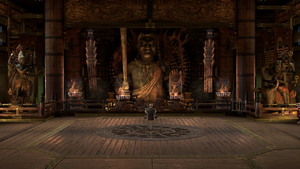  Mishima Dojo in Super Smash Bros. Ultimate. | |
| Universe | Tekken |
| Appears in | Ultimate |
| Availability | Downloadable |
| Crate type | Normal |
| Maximum players | 8 |
Mishima Dojo (三島道場, Mishima Dojo) is a downloadable stage in Super Smash Bros. Ultimate, based on the location of the same name from the Tekken series. It is the home stage of Kazuya, and is bundled with him as part of Challenger Pack 10. It was released on June 29th, 2021.
Stage overview[edit]
The stage's layout is primarily flat, with walls and ceiling sections blocking the left, right and upper blast zones. These can be broken by being attacked or if a fighter is launched into them, with a Special Zoom occurring in the latter event if the fighter is launched with enough force that they will likely be KO'd. After being broken, they will repair themselves after a certain amount of time has passed. If the lower wall is destroyed, it is possible to die from the lower blast zone. Otherwise, a shallow wall prevents fighters dropping below the lower wall, even when the upper wall is destroyed. The amount of damage a surface takes from fighters being knocked into them depends on the speed of the collision, and the weight of the fighter, with heavier fighters requiring less knockback to be launched through the walls and ceiling.
Heihachi Mishima can be seen in front of the large Fudō Myōō statue in the center of the stage, sitting faced away from the action with his arms crossed. When the fighters hit the walls and ceiling, he'll react to it by looking left and right, depending on which walls and ceilings fighters hit. He'll get up, cross up his arms and react to KOs once parts of the walls and ceilings are broken. He does not appear in the background in 8-player battles.
There is a small inscription on the floor that roughly translates to "Kazumi and Heihachi." This is a reference to Tekken lore, where both carved their names into the floor as a symbol of their love.
Ω form and Battlefield form[edit]
For the Ω form and Battlefield form, the walls and ceiling are permanently broken and the stage now floats far above the surface, and thus the stage's ledge walls do not extend below the blast line. The stage is also resized and reshaped to match Final Destination and Battlefield, respectively. The three soft platforms of the Battlefield form are wooden and resemble the wood flooring of the main platform.
Hazards off[edit]
The stage remains unchanged with hazards turned off.
Origin[edit]
The stage is designed around the Mishima Dojo as it appears in Tekken 7, compared to its damaged version in the console port, Tekken 7: Fated Retribution. While the walls and ceiling can not break in Mishima Dojo, they are able to in other Tekken stages; as a gameplay element introduced in Tekken 6 called Wall Break. On the floor of the stage, it is possible to see the names of Heihachi and his deceased wife Kazumi Hachijo in an aiaigasa, which were engraved by them when they first fell in love. This detail is present in the original appearance of Mishima Dojo in Tekken 7, and originates from another similar stage in Tekken 2, Pagoda Temple.
Tournament Legality[edit]
Mishima Dojo is widely banned in tournaments due to the stage being enclosed by two walls and a celing at the start of every match. This can allow for infinites under specific circumstances. While the walls and ceiling are destructible to mitigate this issue, the blast zones are close to the stage, heavily favoring characters with high base knockback once the walls are broken.
Gallery[edit]
Kazuya with Mario.
Kazuya using Flash Tornado against Captain Falcon on Mishima Dojo.
Names in other languages[edit]
Trivia[edit]
- Mishima Dojo is one of four stages in the Super Smash Bros. series to originate from a different fighting game, with the others being Suzaku Castle, King of Fighters Stadium, and Spring Stadium.
- The HP of the dojo surfaces varies, depending on how close they are to the stage's ledges, with the central ceiling having the lowest HP, and the lower walls having the highest.
- Mishima Dojo is the first and only stage which did not appear on Nintendo hardware before its debut in the Super Smash Bros. series.
- Excluding Smash original content, it is unique among all fighters, stages, Assist Trophies, Mii Fighter costumes, bosses, and items in that its only appearance on Nintendo hardware is in the Super Smash Bros. series.
- Andross, Arcade Bunny, Color TV-Game 15, Devil, Dr. Wright, Flies & Hand, Kapp'n, Moon, Nikki (due to the dark background obscuring her drawings), Nintendog, and Thwomp cannot appear from Assist Trophies on this stage. Abra, Alolan Exeggutor, Lugia, and Lunala cannot be summoned from Poké Balls.
- Because stage elements are frozen during Training Mode when the game is paused, when the opponent takes very high knockback, the surfaces remain intact unless the game is unpaused.
- It is possible for Jigglypuff to clip through the shallow wall preventing access to the lower blast zone, by using an uncharged Rollout while facing outwards and in contact with the wall. However, the lower internal wall being present prevents fighters from grabbing the ledge regardless.
- Masahiro Sakurai showed an early version of Mishima Dojo in a YouTube video[1] and showcased several changes made before the final version:
- Sakurai suggested adding more visual detail to the background elements close to the Blast line, as those would be the most visible areas.
- The mountain ridge lines were made to reflect moonlight more.
- The tree density was changed to be more at the bottom and less at the top.
- Sakurai used completely gray-scale images to showcase how characters are difficult to see in shadows.
- The dojo floor went through several changes.
- The wood was given more sheen to look like proper flooring.
- The gaps between the floor boards was narrowed and the colors of these gaps were made lighter.
- The area where the varnish has worn off was shortened.
- Debris on the floor was given more presence to look intentional.
- Debris from the ceiling collapsing was changed to fall more gradually instead of all at once.
- More moon shafts were added after the ceiling collapses.
- The colors on the Battlefield form platforms were altered to contrast more with the background.
- Sakurai suggested adding more visual detail to the background elements close to the Blast line, as those would be the most visible areas.
- In another YouTube video,[2] Sakurai showcased the progression of the destroyed walls. In particular, he noted that the destruction looked too uniform early on, and requested the broken wall boards look more jagged and chaotic to appear as if something randomly crashed through it.
References[edit]
|
| |
|---|---|
| Fighter | Kazuya (SSBU) |
| Stage | Mishima Dojo |
| Other | Heihachi Mishima |
| Spirits | Spirits |
| Music | Ultimate |
